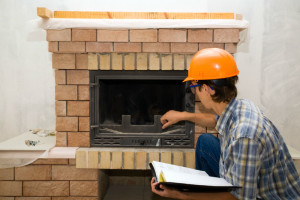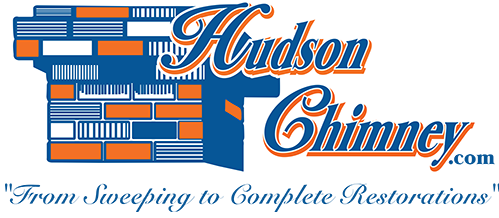by Mark Hudson | May 9, 2017 | chimney maintenance
When you acquire a property whether by inheritance or purchase, or when you sell a property, the chimney is quite a selling point. In fact, a fireplace is the most common factor that home buyers request. However, a new homeowner doesn’t want to be surprised with a faulty fireplace, unsafe chimney, and damaged home because of it.
CSIA Chimney Inspections
The Chimney Safety Institute of America (CSIA) prioritizes consumer safety, and strives to educate the public and train professionals in chimney and fire safety. CSIA credentials are nationally-recognized and its members offer three levels of CSIA inspections that are vital for chimney safety. A level two inspection is required for the transfer of property. It includes the basic assessment of a level one inspection as well as hidden portions that are accessed with special tools. A level two inspection also includes a video scan of the interior portions of the chimney system. In addition, a detailed report for your real estate agent, loan officer, and home buyer. The officials who have an interest in your sale, whether you’re the buyer or seller, will look for a CSIA signature on official documents.
Routine Maintenance and Repairs
When you buy a home with an existing chimney system, you have no assurance that the system has been properly maintained. The required chimney inspection is combined with a home inspection. This discloses any issues that might exist with the home and chimney system. If there is a chimney, you should receive a report of the required inspection. If the seller doesn’t repair damage prior to the sale, you should at least get a recommendation for repairs. Take the costs into account when making an offer for a home. If you’re working with a real estate agent, you might negotiate repairs before your purchase is final.
Selling Your Home
Your fireplace is a valuable selling point during a property sale. It’s wasted if you don’t take advantage. In order to make the most of your sell, you should keep your fireplace and chimney properly maintained. Before you put your home on the market, schedule a chimney sweep! This is so that your prospective buyers can’t smell the smoky soot in the fireplace. Your chimney sweep can assess the system during this appointment and present a report for your legal purposes. If you have been vigilant about your chimney’s maintenance over the years, your inspection should discover surprising damage, but it is still required.
Fireplace Facelift
Is your chimney is functional, but the fireplace is worn? You can update it with a beautiful and efficient fireplace insert. This can work together with your existing chimney. Before a sale is the best time for a fireplace facelift. Why? Because you can increase your price substantially with far less cost than you gain.
Hudson Chimney offers both gas and wood-burning inserts that will fit your space perfectly, whether you’re selling or buying a home. A Hudson Chimney sweep is standing by to make your purchase or sale as easy as possible. Call 904-282-4159 today, or contact us online.
by Mark Hudson | May 5, 2016 | Chimney Inspections
Exterior damage to your masonry chimney is easily noticed, but problems deep within the flue can be impossible for you to see. A lot of damage can be lurking inside your chimney, and you could be endangering yourself and your family by using your fireplace when any damage exists. This is why it is so important to have an annual professional chimney inspection. At Hudson Chimney, we have all been certified by the Chimney Safety Institute of America (CSIA) in properly inspecting chimneys. We know where to look for damage inside your flue, and we perform video scans on certain inspections we do, which allows us to see every inch of the interior of your chimney. If we do find any problems, we have the video footage that we can show you to help you understand the type of repairs needed to correct the issue. We would like to tell you a bit more about the importance of chimney inspections.

What kind of damage can typically be found inside a chimney?
One of the most common problems Hudson Chimney often finds inside chimneys is a cracked chimney liner, which can be very hazardous. If your chimney has suffered a water leak, your liner can suffer from rusting and other corrosion damage and crack and break apart. When your liner has cracks and gaps, the toxic byproducts of combustion can leak into your home. Another issue we see is chimney blockages. Many things can block your flue, including leaves, sticks, nesting materials from birds and wild animals, soot, and creosote. When your chimney is blocked, you are at a higher risk of a chimney fire and a carbon monoxide leak. Something else we often find when we inspect the interior of chimneys is a flue that is not properly sized to the heating appliance. This can cause problems including an overproduction of carbon monoxide, chimney draft issues, and inefficiencies in the operation of your fireplace and chimney.
What is involved in a chimney inspection from Hudson Chimney?
Your chimney inspection will depend on the level you need. Over a decade ago, the National Fire Protection Association (NFPA) adopted three levels of chimney inspections to remove inconsistencies in inspections and streamline the process across the country. Level 1 is the most basic level of inspection, which is included with our annual chimney sweeping services. For this level, we will carefully check out the readily accessible parts of the inside and outside of your chimney and the accessible parts of your heating appliance and its heating connection. If you have changed your heating appliance, are selling or buying a home, or have experienced a chimney fire, earthquake, or severe weather event, you will need a Level 2 inspection. This level includes everything in a Level 1 inspection, a video scan, and an examination of the attic, crawl space, or basement. If we find a potentially hazardous problem, we will recommend you have a Level 3 inspection. This level includes everything in a Level 2 inspection and the removal of components, such as the chimney crown and an interior chimney wall. While a Level 3 inspection may seem destructive, it is necessary for your safety.
Just because your chimney looks great on the outside, you could have hidden hazards lurking inside your flue. Contact us at Hudson Chimney to schedule your annual chimney inspection today.

